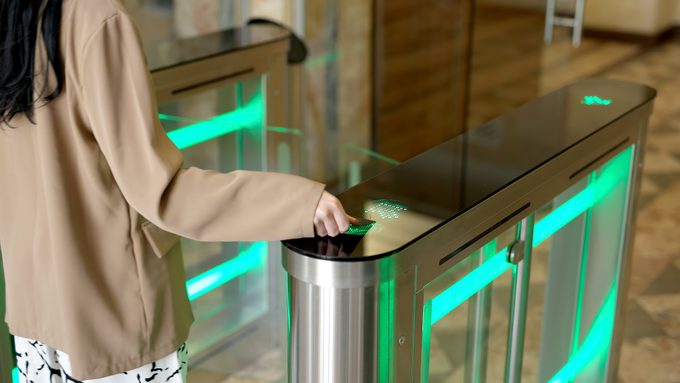Not thrilled about your company’s return-to-office mandate? Coffee badging may be the answer.

Here’s Everything You Need to Know about Coffee Badging, the New Workplace Trend

Whether it’s the ability to wear sweatpants on Zoom calls or the flexibility to throw in some laundry or do a quick Peloton ride, most people love working remotely. In fact, recent data from the Pew Research Center found that nearly half of workers (46%) currently employed in work-from-home positions would likely leave their jobs if they could no longer work from home.
Over the past five years, the shift to hybrid and remote work has been dramatic—and now the tide is changing yet again. As you’re probably all too aware, many companies are requiring employees to head back to the office, at least some of the time. Enter coffee badging, a new workplace trend meant to counteract return-to-office mandates and help people maintain some semblance of work-life balance.
What is it, exactly? We talked to HR experts and workplace-culture pros to better understand what coffee badging is, along with its potential benefits and pitfalls. Keep reading to find out all the details, including whether it can affect your next promotion and how to handle a changing work situation.
Get Reader’s Digest’s Read Up newsletter for more job trends, humor, cleaning, travel, tech and fun facts all week long.
What exactly is coffee badging?
“Coffee badging is when an employee shows up to the office for enough time to have a cup of coffee, show their face and get a ‘badge swipe,’ and then goes home to do the rest of their work,” says Frank Weishaupt, CEO of OWL Labs, a company that provides support for people to work remotely. The term seems to have originated on X in early 2023, and Weishaupt’s team was the first to do a deep dive into the data behind the trend.
While people may assume that hybrid workers are gaming the system with coffee badging, this is generally not the case. It is more about how they allocate their hours in the day and choose to work where they feel the most productive. For example, they may not mind showing up in the office for meetings, team-building or other activities that require a presence, but they may be able to better focus by completing other tasks at home.
What are the pros of coffee badging?
Coffee badging might remind you of signing into a college class and then ducking out the side door, but experts say it’s not simply performative—or sneaky. According to Patrice Williams-Lindo, the CEO of Career Nomad, it can help workers maintain visibility without getting burned out. “Coffee badging keeps employees connected to their teams and leadership, ensuring they remain visible and engaged without committing to unnecessary full-day office time,” Williams-Lindo says. “These brief interactions can spark quick problem-solving or strengthen connections, showing employees’ ability to be present and impactful, even in small doses.”
Here are some of the other benefits:
It can increase productivity
Coffee badging allows for task-based hybrid work that maximizes an employee’s strengths. “Task-based hybrid work improves employees’ productivity levels and satisfaction overall,” Weishaupt says. “They can come into the office for coffee and culture, and head home for more focus time.” More focus time equals more work and better work done.
It saves time and money
“Our study found that hybrid workers spend an average of $61 a day at the office between commuting, grabbing coffee or lunch, and parking,” Weishaupt says. “By coffee badging, employees can cut down on some of those expenses.” How much, exactly? On average, it can help workers save around $42 a day.
It helps with work-life balance
Instead of quiet quitting or being overwhelmed by life, employees can have a better work-life balance, which helps with overall happiness, job satisfaction and, ultimately, productivity. “Employees who coffee badge may also be doing so to spend more time with family at home, pick up kids from school or help with pet care,” says Weishaupt. “Seventy-seven percent of hybrid and in-office workers said they would spend more time with their families if they didn’t have to commute.”
It gives workers more control over their environments
Some people have problems working under overhead lights, and others get distracted by the chatter and small talk in the office environment. “Different people thrive in different environments, and the best managers take time to learn what helps their employees perform at their best,” says Sunday Helmerich, a workplace consultant at the Courage Collective. “Employees should feel comfortable discussing their needs, whether it’s the lighting, noise levels or scheduling that helps them feel most productive.”
What are the cons of coffee badging?

Where there are pros, there are usually cons, and with coffee badging, the main issue is the sneakiness surrounding it. Weishaupt points out that if your boss hasn’t OK’d this and catches you doing it, it may not be looked upon favorably. Here’s why, along with the other reasons it can be problematic:
It can look like you’re gaming the system
“Although 84% of workers surveyed said they’d been caught and their employers didn’t mind, some corporations have started cracking down to prevent coffee badging,” Weishaupt says. “Nearly half (46%) of employees said their companies have added or increased employee-tracking software.”
Beyond that, says Williams-Lindo, employees may be seen as “surface-level contributors” with bad work habits. They may worry that co-workers might not keep them in the loop and bosses may pass them over for a promotion. And they might not be wrong about that.
It can cause friction between co-workers
Because not all roles lend themselves to coffee badging, not everyone may be happy with this arrangement since it seems like the people with greater flexibility are getting preferential treatment. In fact, in organizations where coffee badging is more noticeable, employees report higher frustration, according to Rachel Platt, founder and CEO of PLATTinum Consulting. That perceived inequity may cause the frustrated employees to be less engaged at work as well.
“One client reported last month that half their employees say that they really want the interaction with those that are coffee badging,” says Platt. “And the other half say that they are jealous that those individuals have the guts to flout the rules.”
It can be the worst of both worlds
“Employees still have to invest time and money into their daily commute, removing one of the benefits of working from home,” says David Case, president of Advastar, a recruiting and workplace solutions firm. “On the flip side, they still won’t be in the office during the bulk of their day, so communication and collaboration still need to happen remotely.”
Are there other options for hybrid workers?

Instead of doing something like coffee badging on the sly, a proper hybrid arrangement—discussed with your employer—might be a better way to go. No, some employers may not go for it, but that’s the risk. Set up a one-on-one meeting with your boss, and follow the advice below to give yourself the best shot at making it happen.
Be prepared with metrics
Whether you expect some resistance or not, come prepared with data that can support your assertion that you work as well—or better—from home, Case says. Hard facts, not emotion, will be key here.
Ask for consistency
“Employees may ask for consistent days for teams to be in the office so that the days truly are collaborative and include high-impact interactions,” Platt says. “But if the mandate is for five days per week and that isn’t something you’re willing to commit to, it is time to look for another job.” An employee can always vote with their feet when they find a work arrangement that meets their needs.
Be willing to compromise
Consider what objections your manager is likely to make and have a response ready to give them. Case suggests making it clear that you’re willing to compromise with a half-day hybrid schedule, which could look like going to the office for morning meetings and then returning home to work—with the knowledge and approval of the organization.
Revisit the topic
What works one quarter might not work the next, so revisiting the topic makes sense depending on current projects and workflow. This will help ensure that your boss stays happy and that you don’t miss out on opportunities and promotions. “Establishing trust with [your] manager and colleagues is crucial in these more flexible working arrangements,” says Heather R. Younger, a workplace culture and employee engagement expert.
How should you respond if a colleague is coffee badging?
Reduce finger pointing, and keep in mind that coffee badging often reflects systemic workplace issues, not personal shortcomings. “Instead of judging their frequency in the office, look at the quality of their work and contributions,” Williams-Lindo says. “Coffee badgers who deliver results are simply optimizing their approach.”
Williams-Lindo reminds naysayers that coffee badging isn’t just a trend—it’s a signal. “Employees are rejecting outdated norms and demanding work environments that prioritize results over appearances,” she says.
So while coffee badging may itself feel performative, the same could be said for showing up at the office every day when a person isn’t giving their all. Remember: It’s about the quality of work, not where it gets done … and ultimately, that’s not your decision unless you’re the boss.
Why trust us
At Reader’s Digest, we’re committed to producing high-quality content by writers with expertise and experience in their field in consultation with relevant, qualified experts. We rely on reputable primary sources, including government and professional organizations and academic institutions as well as our writers’ personal experiences where appropriate. We verify all facts and data, back them with credible sourcing and revisit them over time to ensure they remain accurate and up to date. Read more about our team, our contributors and our editorial policies.
Sources:
- Frank Weishaupt, CEO of OWL Labs; email interview, January 2025
- Sunday Helmerich, workplace consultant at the Courage Collective; email interview, January 2025
- Patrice Williams-Lindo, CEO of Career Nomad; email interview, January 2025
- Rachell Platt, founder and CEO of PLATTinum Consulting; email interview, January 2025
- David Case, president of Advastar; email interview, January 2025
- Heather R. Younger, JD, CSP, workplace culture and employee engagement expert; email interview, January 2025
- Pew Research Center: “Many remote workers say they’d be likely to leave their job if they could no longer work from home”
- OWL Labs: “2024 State of Hybrid Work Report”
- OWL Labs: “Task-based work is the newest approach to improving employee engagement”























